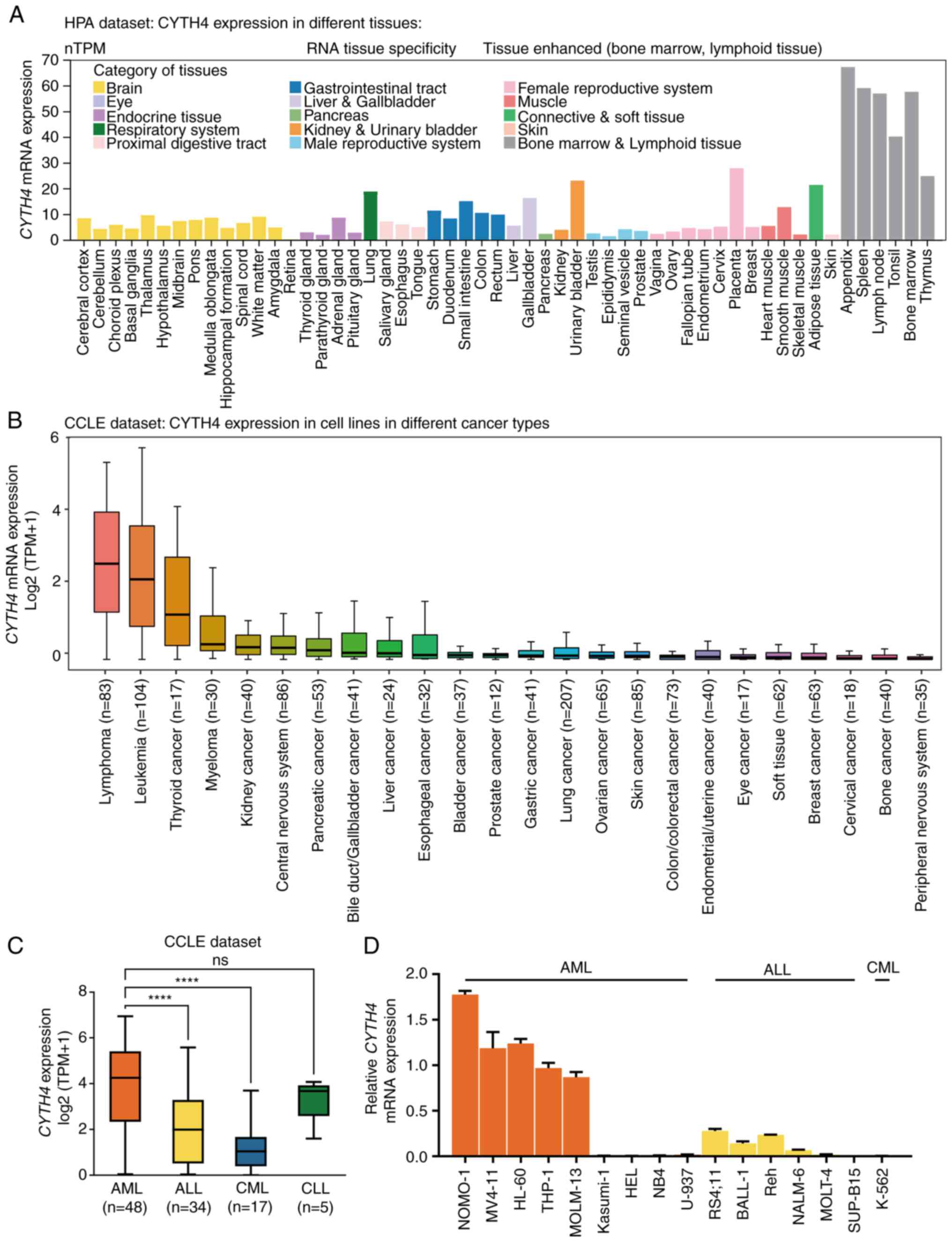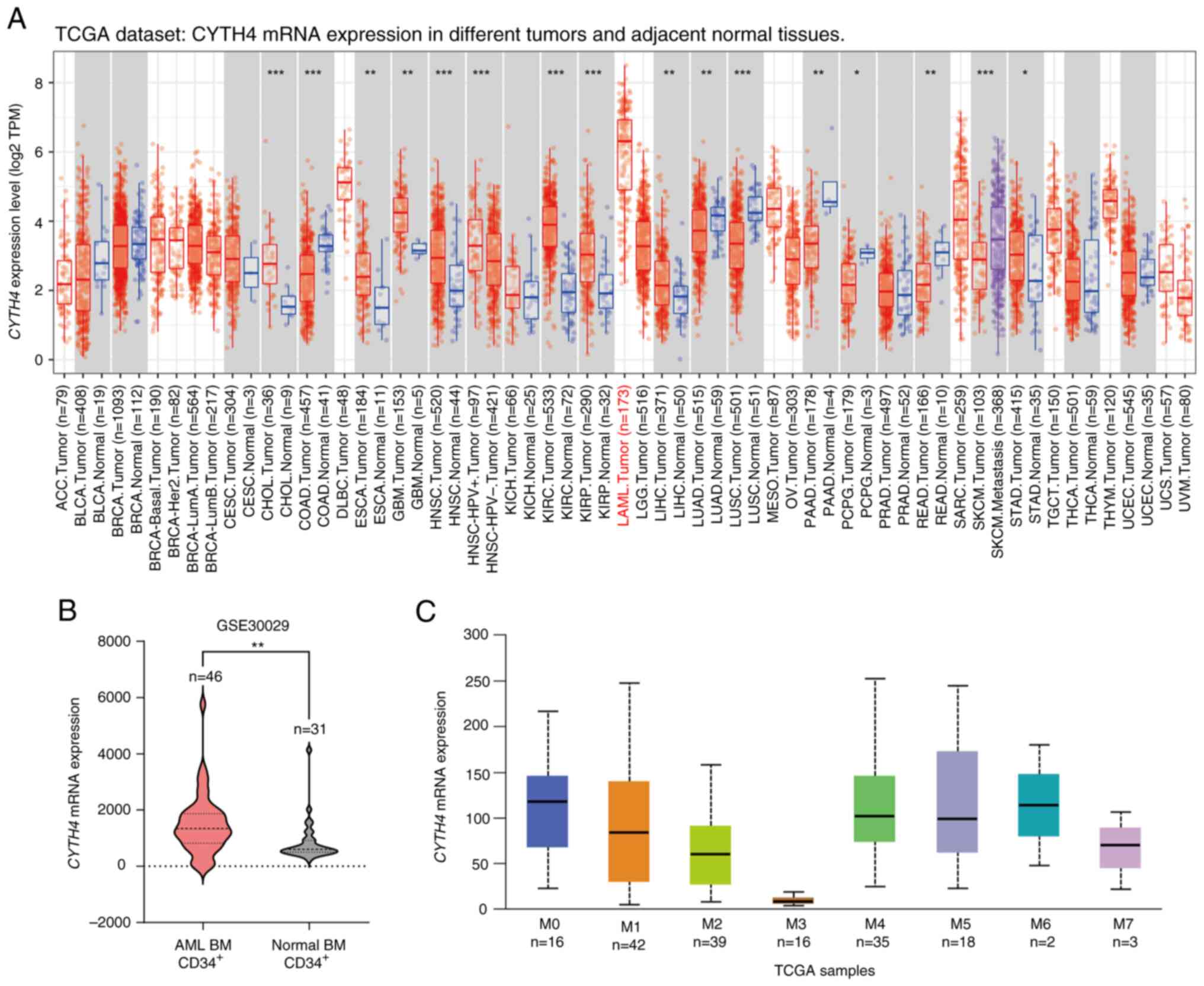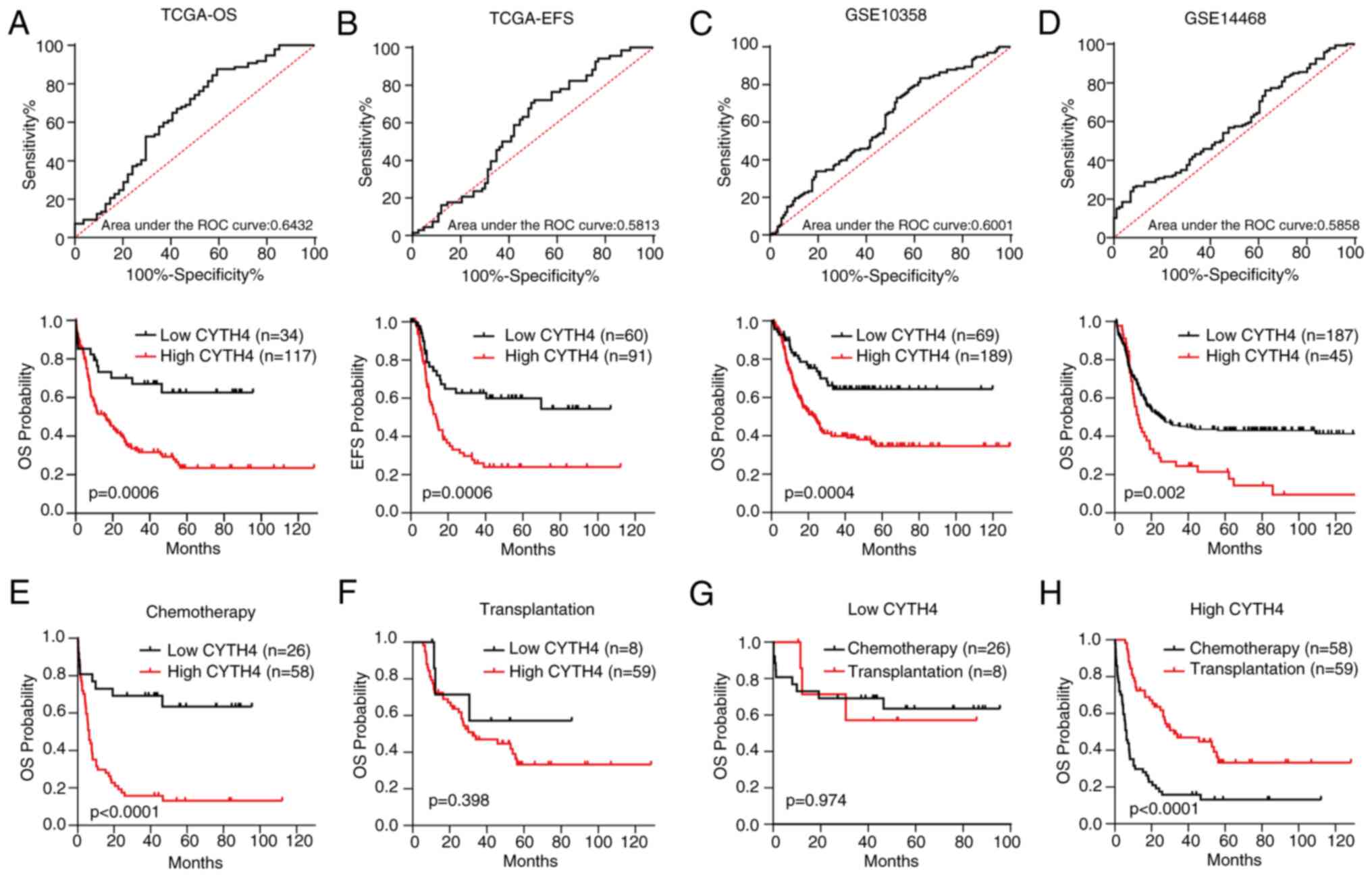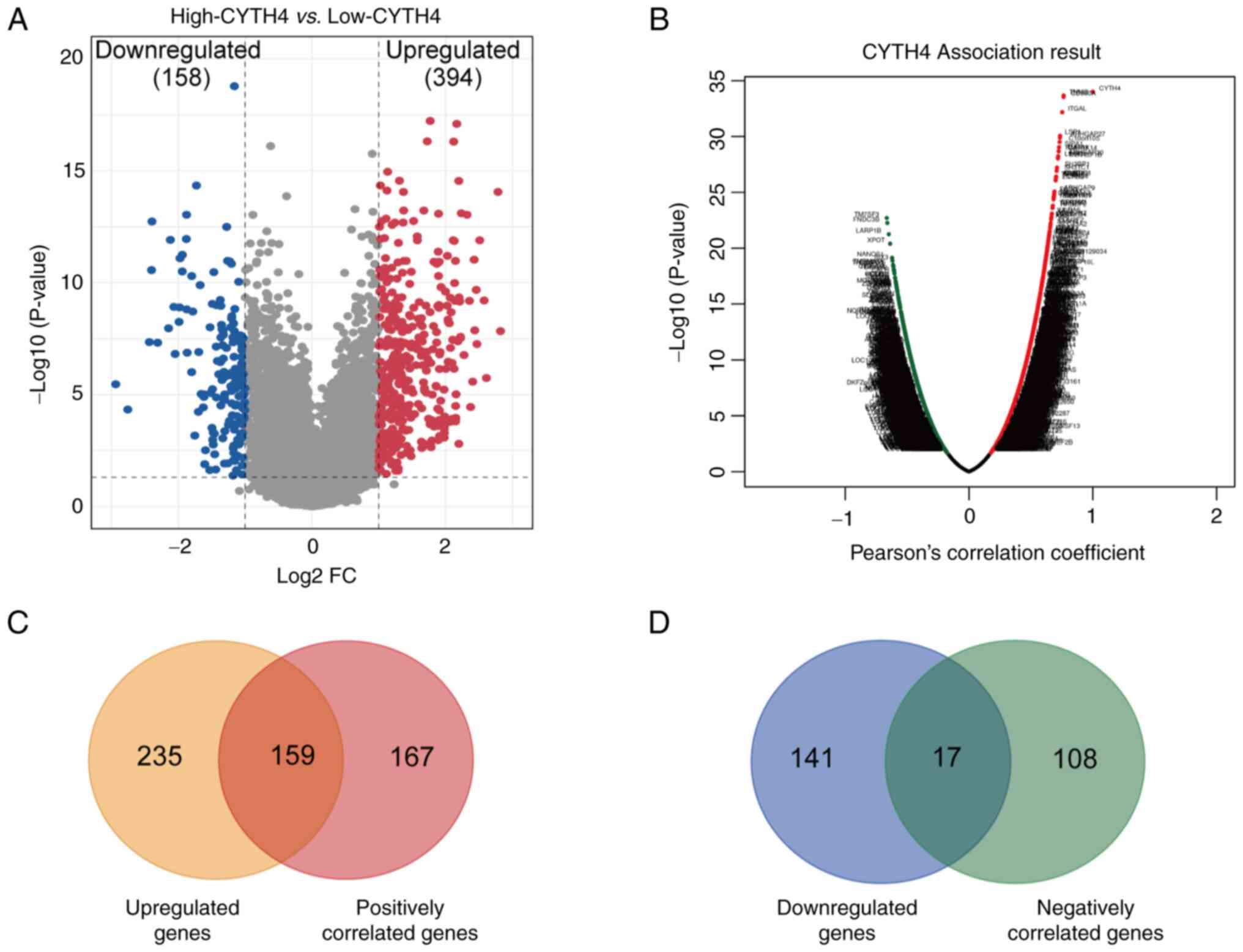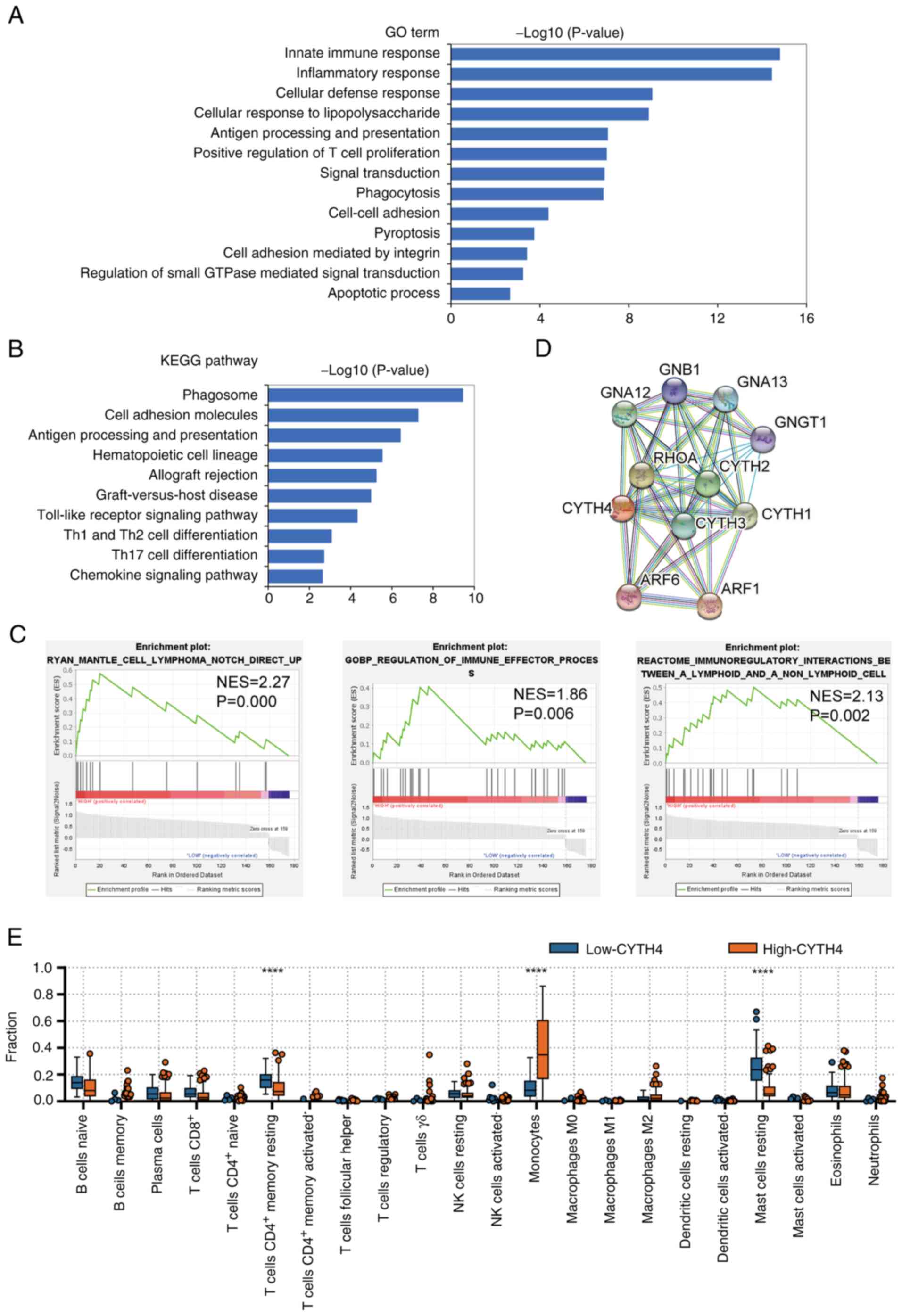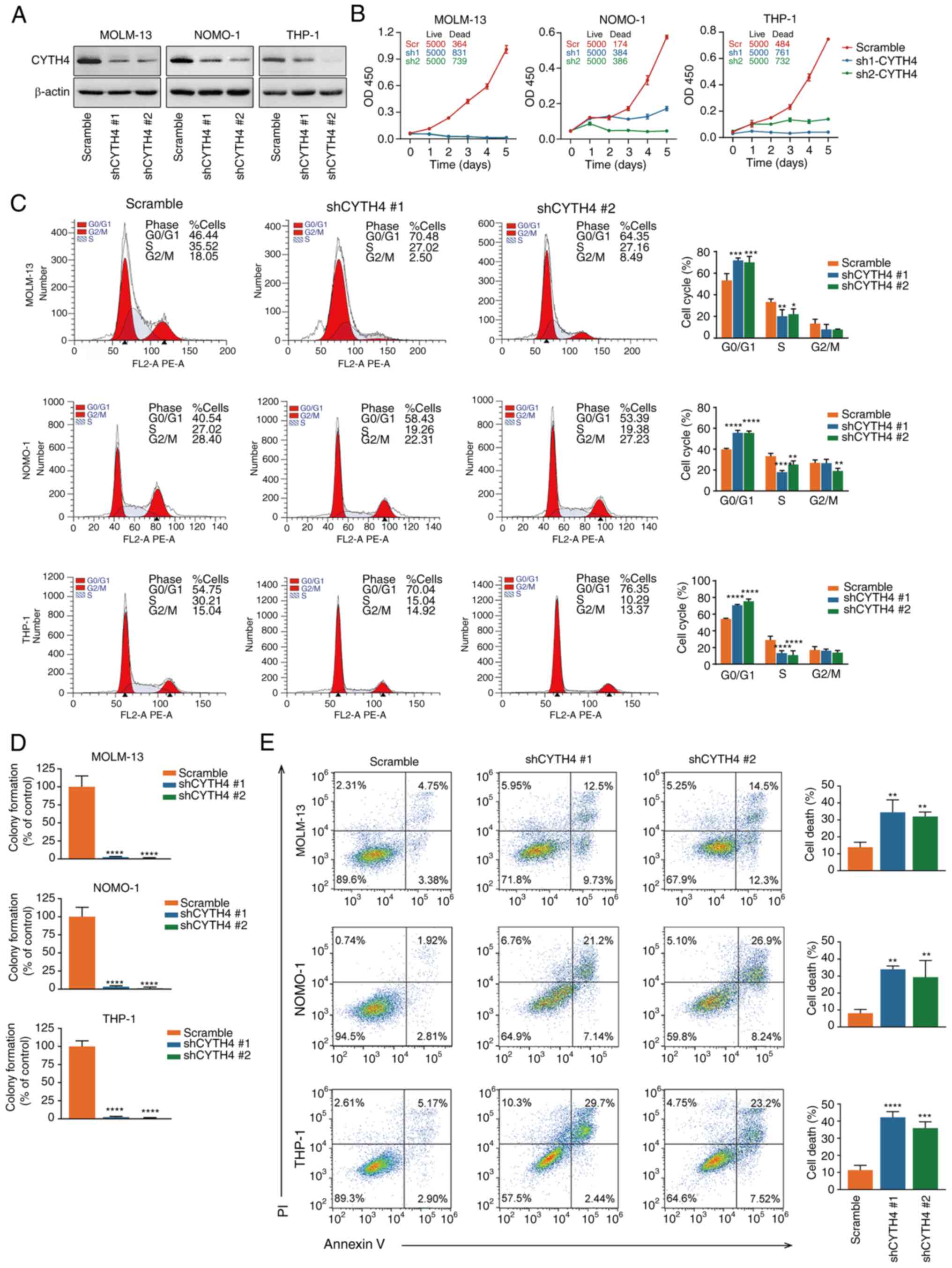|
1
|
Döhner H, Wei AH, Appelbaum FR, Craddock
C, DiNardo CD, Dombret H, Ebert BL, Fenaux P, Godley LA, Hasserjian
RP, et al: Diagnosis and management of AML in adults: 2022 ELN
recommendations from an international expert panel. Blood.
140:1345–1377. 2022. View Article : Google Scholar : PubMed/NCBI
|
|
2
|
SEER*Explorer, . An interactive website
for SEER cancer statistics. Surveillance Research Program, National
Cancer Institute. 2023 Apr 19;Available from:. https://seer.cancer.gov/statistics-network/explorer/
|
|
3
|
Guan W, Zhou L, Li Y, Yang E, Liu Y, Lv N,
Fu L, Ding Y, Wang N, Fang N, et al: Profiling of somatic mutations
and fusion genes in acute myeloid leukemia patients with FLT3-ITD
or FLT3-TKD mutation at diagnosis reveals distinct evolutionary
patterns. Exp Hematol Oncol. 10:272021. View Article : Google Scholar : PubMed/NCBI
|
|
4
|
Menezes AC, Jones R, Shrestha A, Nicholson
R, Leckenby A, Azevedo A, Davies S, Baker S, Gilkes AF, Darley RL
and Tonks A: Increased expression of RUNX3 inhibits normal human
myeloid development. Leukemia. 36:1769–1780. 2022. View Article : Google Scholar : PubMed/NCBI
|
|
5
|
Yan F, Li J, Milosevic J, Petroni R, Liu
S, Shi Z, Yuan S, Reynaga JM, Qi Y, Rico J, et al: KAT6A and ENL
form an epigenetic transcriptional control module to drive critical
leukemogenic gene-expression programs. Cancer Discov. 12:792–811.
2022. View Article : Google Scholar : PubMed/NCBI
|
|
6
|
Li XP, Zhang WN, Mao JY, Zhao BT, Jiang L
and Gao Y: Integration of CD34+CD117dim
population signature improves the prognosis prediction of acute
myeloid leukemia. J Transl Med. 20:3592022. View Article : Google Scholar : PubMed/NCBI
|
|
7
|
Duncavage EJ, Schroeder MC, O'Laughlin M,
Wilson R, MacMillan S, Bohannon A, Kruchowski S, Garza J, Du F,
Hughes AEO, et al: Genome sequencing as an alternative to
cytogenetic analysis in myeloid cancers. N Eng J Med. 384:924–935.
2021. View Article : Google Scholar
|
|
8
|
Letai A: Precision medicine in AML:
Function plus-omics is better than either alone. Cancer Cell.
40:804–806. 2022. View Article : Google Scholar : PubMed/NCBI
|
|
9
|
Yi C, Cai C, Cheng Z, Zhao Y, Yang X, Wu
Y, Wang X, Jin Z, Xiang Y, Jin M, et al: Genome-wide CRISPR-Cas9
screening identifies the CYTH2 host gene as a potential therapeutic
target of influenza viral infection. Cell Rep. 38:1105592022.
View Article : Google Scholar : PubMed/NCBI
|
|
10
|
Wang Y, Çil Ç, Harnett MM and Pineda MA:
Cytohesin-2/ARNO: A novel bridge between cell migration and
immunoregulation in synovial fibroblasts. Front Immunol.
12:8098962022. View Article : Google Scholar : PubMed/NCBI
|
|
11
|
Ratcliffe CDH, Siddiqui N, Coelho PP,
Laterreur N, Cookey TN, Sonenberg N and Park M: HGF-induced
migration depends on the PI(3,4,5)P3-binding
microexon-spliced variant of the Arf6 exchange factor cytohesin-1.
J Cell Biol. 218:285–298. 2019. View Article : Google Scholar : PubMed/NCBI
|
|
12
|
Miyamoto Y, Torii T, Homma K, Oizumi H,
Ohbuchi K, Mizoguchi K, Takashima S and Yamauchi J: The adaptor
SH2B1 and the phosphatase PTP4A1 regulate the phosphorylation of
cytohesin-2 in myelinating schwann cells in mice. Sci Signal.
15:eabi52762022. View Article : Google Scholar : PubMed/NCBI
|
|
13
|
Donaldson JG and Jackson CL: ARF family G
proteins and their regulators: Roles in membrane transport,
development and disease. Nat Rev Mol Cell Biol. 12:362–375. 2011.
View Article : Google Scholar : PubMed/NCBI
|
|
14
|
Lee YJ, Bae JH, Kim WI, Kim JH, Cho SW,
Lee SH, Jeon JS, Nam HS, Lee SH, Lee SH and Cho MK: Cytohesin-2 is
upregulated in malignant melanoma and contributes to tumor growth.
Ann Dermatol. 31:93–96. 2019. View Article : Google Scholar : PubMed/NCBI
|
|
15
|
Pan T, Sun J, Hu J, Hu Y, Zhou J, Chen Z,
Xu D, Xu W, Zheng S and Zhang S: Cytohesins/ARNO: The function in
colorectal cancer cells. PloS One. 9:e909972014. View Article : Google Scholar : PubMed/NCBI
|
|
16
|
Xu K, Gao J, Yang X, Yao Y and Liu Q:
Cytohesin-2 as a novel prognostic marker for hepatocellular
carcinoma. Oncol Rep. 29:2211–2218. 2013. View Article : Google Scholar : PubMed/NCBI
|
|
17
|
Pan T, Sun J, Zhou J, Fu Z, Hu Y, Zheng S
and Zhang S: Function and mode of action of cytohesins in the
epidermal growth factor pathway in colorectal cancer cells. Oncol
Lett. 5:521–526. 2013. View Article : Google Scholar : PubMed/NCBI
|
|
18
|
Fu Y, Li J, Feng MX, Yang XM, Wang YH,
Zhang YL, Qin W, Xia Q and Zhang ZG: Cytohesin-3 is upregulated in
hepatocellular carcinoma and contributes to tumor growth and
vascular invasion. Int J Clin Exp Pathol. 7:2123–2132.
2014.PubMed/NCBI
|
|
19
|
Bill A, Schmitz A, König K, Heukamp LC,
Hannam JS and Famulok M: Anti-proliferative effect of cytohesin
inhibition in gefitinib-resistant lung cancer cells. PloS One.
7:e411792012. View Article : Google Scholar : PubMed/NCBI
|
|
20
|
Zhang Q, Wang Q, Wu S and Zhang J:
Clinical implication and immunological characterisation of the
ARF-GEF family member CYTH4 in ovarian cancer. Autoimmunity.
53:434–442. 2020. View Article : Google Scholar : PubMed/NCBI
|
|
21
|
Ren WX, Guo H, Lin SY, Chen SY, Long YY,
Xu LY, Wu D, Cao YL, Qu J, Yang BL, et al: Targeting cytohesin-1
suppresses acute myeloid leukemia progression and overcomes
resistance to ABT-199. Acta Pharmacol Sin. Aug 29–2023.(Epub ahead
of print).
|
|
22
|
Uhlén M, Fagerberg L, Hallström BM,
Lindskog C, Oksvold P, Mardinoglu A, Sivertsson Å, Kampf C,
Sjöstedt E, Asplund A, et al: Proteomics. Tissue-based map of the
human proteome. Science. 347:12604192015. View Article : Google Scholar : PubMed/NCBI
|
|
23
|
Ghandi M, Huang FW, Jané-Valbuena J,
Kryukov GV, Lo CC, McDonald ER III, Barretina J, Gelfand ET,
Bielski CM, Li H, et al: Next-generation characterization of the
cancer cell line encyclopedia. Nature. 569:503–508. 2019.
View Article : Google Scholar : PubMed/NCBI
|
|
24
|
Cancer Genome Atlas Research Network, .
Ley TJ, Miller C, Ding L, Raphael BJ, Mungall AJ, Robertson A,
Hoadley K, Triche TJ Jr, Laird PW, et al: Genomic and epigenomic
landscapes of adult de novo acute myeloid leukemia. N Engl J Med.
368:2059–2074. 2013. View Article : Google Scholar : PubMed/NCBI
|
|
25
|
Li T, Fu J, Zeng Z, Cohen D, Li J, Chen Q,
Li B and Liu XS: TIMER2.0 for analysis of tumor-infiltrating immune
cells. Nucleic Acids Res. 48:W509–W514. 2020. View Article : Google Scholar : PubMed/NCBI
|
|
26
|
Chandrashekar DS, Karthikeyan SK, Korla
PK, Patel H, Shovon AR, Athar M, Netto GJ, Qin ZS, Kumar S, Manne
U, et al: UALCAN: An update to the integrated cancer data analysis
platform. Neoplasia. 25:18–27. 2022. View Article : Google Scholar : PubMed/NCBI
|
|
27
|
de Jonge HJ, Woolthuis CM, Vos AZ, Mulder
A, van den Berg E, Kluin PM, van der Weide K, de Bont ES, Huls G,
Vellenga E and Schuringa JJ: Gene expression profiling in the
leukemic stem cell-enriched CD34+ fraction identifies target genes
that predict prognosis in normal karyotype AML. Leukemia.
25:1825–1833. 2011. View Article : Google Scholar : PubMed/NCBI
|
|
28
|
Tomasson MH, Xiang Z, Walgren R, Zhao Y,
Kasai Y, Miner T, Ries RE, Lubman O, Fremont DH, McLellan MD, et
al: Somatic mutations and germline sequence variants in the
expressed tyrosine kinase genes of patients with de novo acute
myeloid leukemia. Blood. 111:4797–4808. 2008. View Article : Google Scholar : PubMed/NCBI
|
|
29
|
Wouters BJ, Löwenberg B,
Erpelinck-Verschueren CA, van Putten WL, Valk PJ and Delwel R:
Double CEBPA mutations, but not single CEBPA mutations, define a
subgroup of acute myeloid leukemia with a distinctive gene
expression profile that is uniquely associated with a favorable
outcome. Blood. 113:3088–3091. 2009. View Article : Google Scholar : PubMed/NCBI
|
|
30
|
Love MI, Huber W and Anders S: Moderated
estimation of fold change and dispersion for RNA-seq data with
DESeq2. Genome Biol. 15:5502014. View Article : Google Scholar : PubMed/NCBI
|
|
31
|
Vasaikar SV, Straub P, Wang J and Zhang B:
LinkedOmics: Analyzing multi-omics data within and across 32 cancer
types. Nucleic Acids Res. 46:D956–D963. 2018. View Article : Google Scholar : PubMed/NCBI
|
|
32
|
Sherman BT, Hao M, Qiu J, Jiao X, Baseler
MW, Lane HC, Imamichi T and Chang W: DAVID: A web server for
functional enrichment analysis and functional annotation of gene
lists (2021 update). Nucleic Acids Res. 50:W216–W221. 2022.
View Article : Google Scholar : PubMed/NCBI
|
|
33
|
Subramanian A, Tamayo P, Mootha VK,
Mukherjee S, Ebert BL, Gillette MA, Paulovich A, Pomeroy SL, Golub
TR, Lander ES and Mesirov JP: Gene set enrichment analysis: A
knowledge-based approach for interpreting genome-wide expression
profiles. Proc Natl Acad Sci USA. 102:15545–15550. 2005. View Article : Google Scholar : PubMed/NCBI
|
|
34
|
Newman AM, Steen CB, Liu CL, Gentles AJ,
Chaudhuri AA, Scherer F, Khodadoust MS, Esfahani MS, Luca BA,
Steiner D, et al: Determining cell type abundance and expression
from bulk tissues with digital cytometry. Nat Biotechnol.
37:773–782. 2019. View Article : Google Scholar : PubMed/NCBI
|
|
35
|
Livak KJ and Schmittgen TD: Analysis of
relative gene expression data using real-time quantitative PCR and
the 2(−Delta Delta C(T)) method. Methods. 25:402–408. 2001.
View Article : Google Scholar : PubMed/NCBI
|
|
36
|
Short NJ and Kantarjian H: Choosing
between intensive and less intensive front-line treatment
approaches for older patients with newly diagnosed acute myeloid
leukaemia. The Lancet Haematology. 9:e535–e545. 2022. View Article : Google Scholar : PubMed/NCBI
|
|
37
|
Ito A, Fukaya M, Okamoto H and Sakagami H:
Physiological and pathological roles of the cytohesin family in
neurons. Int J Mol Sci. 23:50872022. View Article : Google Scholar : PubMed/NCBI
|
|
38
|
Stengel KR, Ellis JD, Spielman CL, Bomber
ML and Hiebert SW: Definition of a small core transcriptional
circuit regulated by AML1-ETO. Mol Cell. 81:530–545.e5. 2021.
View Article : Google Scholar : PubMed/NCBI
|
|
39
|
Gatua M, Navari M, Ong'ondi M, Onyango N,
Kaggia S, Rogena E, Visani G, Abinya NA and Piccaluga PP: Molecular
profiling of kenyan acute myeloid leukemia patients. Front Genet.
13:8437052022. View Article : Google Scholar : PubMed/NCBI
|
|
40
|
Wang H, Li Y, Lv N, Li Y, Wang L and Yu L:
Predictors of clinical responses to hypomethylating agents in acute
myeloid leukemia or myelodysplastic syndromes. Ann Hematol.
97:2025–2038. 2018. View Article : Google Scholar : PubMed/NCBI
|
|
41
|
Percival ME, Lai C, Estey E and Hourigan
CS: Bone marrow evaluation for diagnosis and monitoring of acute
myeloid leukemia. Blood Rev. 31:185–192. 2017. View Article : Google Scholar : PubMed/NCBI
|
|
42
|
Chergui A and Reagan JL: Immunotherapy in
acute leukemias: Past success paves the way for future progress.
Cancers (Basel). 15:41372023. View Article : Google Scholar : PubMed/NCBI
|



